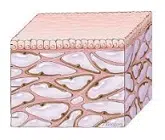Before entering fully into the meaning of the term interstice, we are going to proceed to know its etymological origin. In this case, we can establish that it derives from Latin, exactly from the word "interstitium", which can be translated as "space between two bodies" and that it is the result of the sum of three lexical components:
-The prefix «inter-«, which means «between».
-The adjective «statum», which is synonymous with «detained» or «unemployed».
-The suffix «-io», which is used to indicate «result».
According to the dictionary of the Royal Spanish Academy ( RAE ), this term has two meanings.
 The idea of gap can be used to refer to the small space that is between two bodies or between two components of a body. In the field of biology, the space filled with fluid that is located between the skin and the body organs is called the interstitium.
The idea of gap can be used to refer to the small space that is between two bodies or between two components of a body. In the field of biology, the space filled with fluid that is located between the skin and the body organs is called the interstitium.
This interstitial space has been described by some specialists as a new organ , although others prefer not to give it that name. The interstitium has cavities with interstitial fluid , a fluid derived from blood plasma.
In the human body, the interstitium has the function of storing and transporting solutes and nutrients that are distributed between cells and organs. It is also believed that it could cushion tissues, preventing damage to the daily functioning of blood vessels, muscles and organs.
In the same way, we cannot ignore the existence of what is known as the pulmonary interstitium. We have to establish that what this is responsible for is functioning as support for the structure of the lung and comes to separate what are the blood capillaries from the pulmonary alveoli. You have to know that, to perform its function as such, it is made up of a set of connective-type cells and also fibers.
Specifically, we can indicate that it is divided into three clearly differentiated parts: the parenchymal interstitium, the so-called subpleural interstitium and, finally, the axial or peribronchovascular interstitium space.
There are a series of pathologies that can affect this pulmonary interstitium. Among them, which are included in a group called interstitial lung diseases, range from eosinophilic pneumonia to idiopathic pulmonary fibrosis.
In the field of mineralogy , the empty space that appears between the atoms that make up a crystalline network or between the grains of a rock is called the interstice. Sometimes, other foreign atoms are introduced into the interstices, becoming impurities in the crystal.
Interstice, finally, is the distance or space that exists between two places or between two moments. In this case, the concept is used in a similar way to the idea of interval . For example: «In a gap in his professional activity, the doctor spoke with our magazine» , «The Peruvian writer's new book is developed in the gap between fiction and non-fiction» .
Among the words that can function as synonyms for gap, we can highlight both crack and gap , slit, opening, fissure, hole or cleft.
